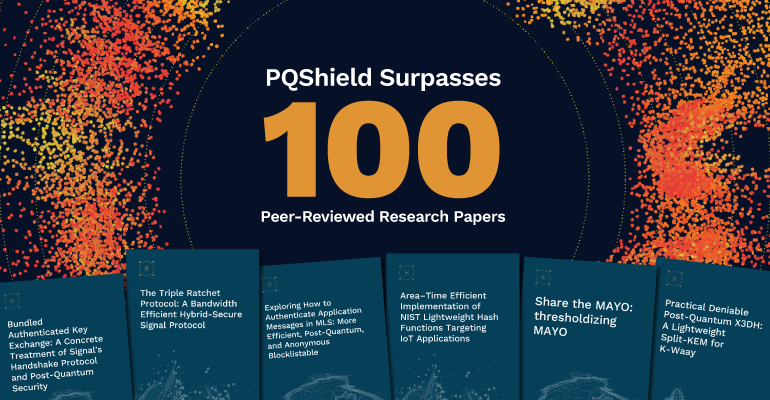PQShield has just released its 100th research paper – a study on Jazzline correctness proofs that won the Distinguished Paper Award recently at CCS 2025.
Since the company began, fresh out of the University of Oxford in 2018, publishing academic research and engaging with our peers across the cryptographic community is a cornerstone of what we do at PQShield.
This research work is the foundation for all of our real-world PQC products and partnerships. Publishing our 100th paper demonstrates PQShield’s unique position as a company that has not only been a leading contributor to the theoretical foundations of PQC, but is also driving commercial deployment of these ideas and securing real-world systems.
A history of PQShield’s research
PQC itself is an academic innovation. We operate in a relatively “new” field — Shor’s algorithm, which is legendary among cryptographers for spotting the problem that quantum computers pose for classical encryption, was only published in 1994.
Since 2018, we’ve been at the forefront of cryptographic innovation – pioneering post-quantum research and guiding the industry through its most demanding supply chain transformations.
Our research has supported the worldwide effort to standardise post-quantum cryptography, including our collaboration with NIST ahead of last year’s official standard releases. As adoption accelerates, our work continues to enhance the strength and resilience of these standards in practice.
One of our most recent results is the research paper “ML-DSA Masking Sweetened with SUCRE: A Shuffle-and-Unmask Countermeasure for Rejection Sampling”, to appear in TCHES 2026. It provides new improvements in masking the NIST standard ML-DSA, an implementation-level countermeasure that makes it more resistant to physical attacks.
As with all our work, our research is dedicated to enabling the real-world rollout of post-quantum cryptography. Our team focuses on the complex use cases and implementation challenges the global cryptography community must address ahead of the 2035 migration deadline.
Our study “Revisiting PQ WireGuard: A Comprehensive Security Analysis With a New Design Using Reinforced KEMs”, to be published at IEEE Symposium on Security & Privacy 2026, is an example of PQShield research with a specific focus on high-performance applications. Our team members Shuichi Katsumata, Guilhem Niot and Thom Wiggers, together with AIST researcher Keitaro Hashimoto, developed a new approach to Wireguard – a VPN renowned for being fast, lightweight, and highly secure – so that it could comfortably adapt to post-quantum cryptography. Our work shows that existing protocols can be upgraded to post-quantum security with minimal impact on their performance.
We’re proud that the academic and cryptographic community has recognised our research over the years as well. Our research colleague Ben Marshall co-authored a crucial paper on assessing power leakage that received the Best Paper award at CHES 2021. Recently, Pierre-Yves Strub received a distinguished paper award for his contributions to a paper on Jazzline, a proofing method that feeds into PQShield’s own high-assurance implementations of ML-KEM and ML-DSA. This now brings the count to five papers that have been recognised as distinguished or best papers at top-tier conferences.
Cooperation as the key to progress
We have advanced PQC by collaborating with academic institutions, government bodies, and cybersecurity experts across the world.
We started working on secure messaging as early as 2020. Our works sparked discussions, followed by collaborations, and we ended up collaborating with The Signal Foundation on the development of their new Sparse Post Quantum Ratchet (SPQR) protocol. This advance, which you can read about here, is the result of an extended collaboration between organisations and offers Signal users stronger post-quantum protections without compromising security. Our work on this is also documented in one of our 100 research papers here.
Another example is our work on mask compression. Masking is a critical technique for side-channel protection. This technique to reduce the memory footprint of masking was developed by PQShield, thereby enhancing its portability and implementation cost. We collaborated with ANSSI researcher Mélissa Rossi (now at CryptoExperts) in order to prove its security.
Cross-industry collaboration is vital for translating post-quantum research into secure, scalable implementations the world will rely on. We’re proud that our team of cryptographers are actively working with security agencies and governing bodies such as NIST, IETF, NCSC, and NEDO to share expertise and build a more secure future.
The next 100?
We’re only at the beginning.
Our first 100 papers shaped how post-quantum cryptography moves from theory to practice. The next 100 will shape how it scales – into every device, every system, and every corner of the connected world within the next ten years. For example, we’re working on:
- High-assurance, side-channel-resistant implementations for embedded and silicon
- Threshold cryptography more resilient key management
- Next-generation secure messaging
If you are moving to PQC, or building products that must be safe for the long haul: let’s collaborate. Explore our publications and talk to our team.

